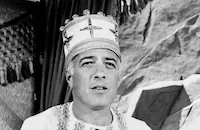The Explosive Generation

Brief Synopsis
Cast & Crew
Buzz Kulik
William Shatner
Patty Mccormack
Lee Kinsolving
Billy Gray
Steve Dunne
Film Details
Technical Specs

Synopsis
Janet Sommers, a high school senior, is persuaded to spend the night at a rented beach house with her boyfriend, Dan Carlyle, because she is afraid of losing his affection. The next day at school, Janet suggests to Peter Gifford, the seniors' favorite teacher, that sex is the most important problem facing young people, and they ask him to give them the sex education their parents failed to provide. He suggests they write unsigned essays on the subject to read and discuss in class. The proposal causes an uproar among mothers active in the PTA, and Gifford is ordered by his principal, Mr. Morton, to destroy the papers. He is suspended when he refuses to comply. The students rally to his defense by going on a "silence strike," which reaches its peak at a basketball game; the entire gym is silent except for the sound of the ball and the referee's whistle. While the game is in progress, Janet reads her mother the paper she wrote for Gifford's class. Mrs. Sommers sees the wisdom of Gifford's efforts, and she aids in having him reinstated. The class resumes, and Gifford reads the first of the controversial papers.

Director
Buzz Kulik
Cast

William Shatner

Patty Mccormack
Lee Kinsolving

Billy Gray
Steve Dunne
Arch Johnson

Virginia Field

Phillip Terry
Hanna Landy

Edward Platt
Suzi Carnell

Jocelyn Brando

Beau Bridges
Peter Virgo Jr.
Bruce Kerner
Peter Virgo Sr.
Mark Lowell
Judee Morton
Jan Norris
Stafford Repp
Vito Scotti
Anne Dore
Michael Gibbs
Ronnie Kelman
Lee Harris
Jim D'arcy
Crew
Max Barcutt
William Bernds
Hal Borne
Stanley Colbert
Ted Coodley
Dorothy Cormack
Floyd Crosby
Alexis Davidoff
Joseph Landon
Joseph Landon
Raoul Pagel
Betty Pedretti
Lou Place
Melvin Shapiro
Dean Spencer

Film Details
Technical Specs

Articles
The Explosive Generation
From the title of the low-budget high school drama The Explosive Generation (1961), one might expect a cheaply churned out exploitation film of student unrest and teens gone wild. Cheap might be accurate the budget limitations can be seen in everything from the flat photography to the blandly generic sets and settings and wardrobe to the simple efficiency of scenes shot in long, unbroken takes (the editing budget was apparently reserved for a few key dramatic moments). But the story itself has serious issues on its mind and a rather surprising message for a film made in 1961. The Explosive Generation turns out to be an early celebration of social protest from the youth generation.
A young William Shatner gets top billing as Peter Gifford, a progressive teacher in a white suburban high school. The Canadian-born actor was a busy man at the time, with a full slate of stage and live television appearances, but The Explosive Generation was only his second feature film role, after his debut in Richard Brooks' movie adaptation of The Brothers Karamazov (1958), and his first leading role. There's an easy-going warmth to his performance that makes his rapport with his students feel natural, and he underplays his soon-to-be trademark intensity as the dedicated and passionate teacher whose ideals are put to the test when they rise to his challenge.
Gifford asks his senior class to discuss the issues that matter most to high school seniors preparing for adulthood. Their answer makes him uncomfortable: sex. His respect for the kids and his frustration with the approved lessons ("This curriculum is a joke," he complains to a fellow teacher) overcomes his hesitation and he invites them to compose essays and questions for the next class. Panicked parents turn the event into a scandal and pressure the harried school principal to stop the "sex education" of this permissive teacher at all costs. Edward Platt, who was a much more progressive authority figure to James Dean in Rebel Without a Cause, effectively plays the principal with a realistic streak of wavering idealism overwhelmed by bureaucratic responsibility.
The Bad Seed's (1956) Patty McCormack makes her transition from child star to mature actress as Janet Sommers, the high school senior who inadvertently opens the door to the crisis when she brings up the issue in class. The film opens with Janet and Dan Carlyle (Lee Kinsolving) spending the night together at a friend's beach house and returning to school the next day knotted in nervous confusion. The suppressed truth about what actually happened that night hangs over the film like a guilty secret that these kids are too ashamed to discuss with their oblivious, self-satisfied parents who do more yelling than listening. What begins as a story of teen sex and peer pressure slowly evolves into a drama of social protest as the once self-involved kids (including Beau Bridges in a small role) pull together to stand up for their education and their free speech rights, and their inspired non-violent protest at the climax is a weirdly mesmerizing tribute to youth solidarity.
Director Buzz Kulick, a TV veteran making his feature debut, brings not just his training for fast and efficient shoots, but also a complexity of the characters and situation that was a hallmark of shows like Playhouse 90 and The Naked City and a documentary immediacy to much of the high school location shooting. It injects a verisimilitude to the scenes of student protest, which stand in marked contrast to the almost generic studio sets. Kulick went on to direct such films as Villa Rides (1968) and Steve McQueen's final film The Hunter (1980), but his greatest success came in his long run of TV movies (such as Brian's Song, 1971) and mini-series (From Here to Eternity, 1979).
The script by Joseph Landon (who also scripted Hoodlum Priest, 1961) is a strange mix of intelligent conversation about serious issues and stiff speechmaking as the kids confront their parents. The moments with the teens suffer from inconsistent performances and half-hearted sprinkles of hep dialogue ("Crazy, man!"), but their dynamic is compelling and the scenes have a looseness to them. The pounding bongo percussion score that accompanies their scenes brings an odd but effective atmosphere to their experience.
The transformation of the students from oblivious teens to concerned and determined students through civil rights protest is a dynamic portrait in activism, a precursor to the counterculture cinema of the late 1960s in clean-cut fifties garb. The Explosive Generation presents high school students as intelligent and mature people ready to face the serious issues of their future not just sex, but war, military service, the bomb with remarkable and sincere respect and finds not merely heroism but the essence of responsible citizenship in their rally to stand up for their rights in the face of adult authority. That's as timely a lesson as you'll find.
Producer: Stanley Colbert
Director: Buzz Kulik
Screenplay: Joseph Landon
Cinematography: Floyd Crosby
Film Editing: Melvin Shapiro
Music: Hal Borne
Cast: William Shatner (Peter Gifford), Lee Kinsolving (Dan Carlyle), Patty McCormack (Janet Sommers), Billy Gray (Bobby Herman Jr.), Virginia Field (Mrs. Sommers), Phillip Terry (Mr. Carlyle).
BW-89m.
by Sean Axmaker

The Explosive Generation
Quotes
Trivia
Miscellaneous Notes
Released in United States 1961
Released in United States 1961













